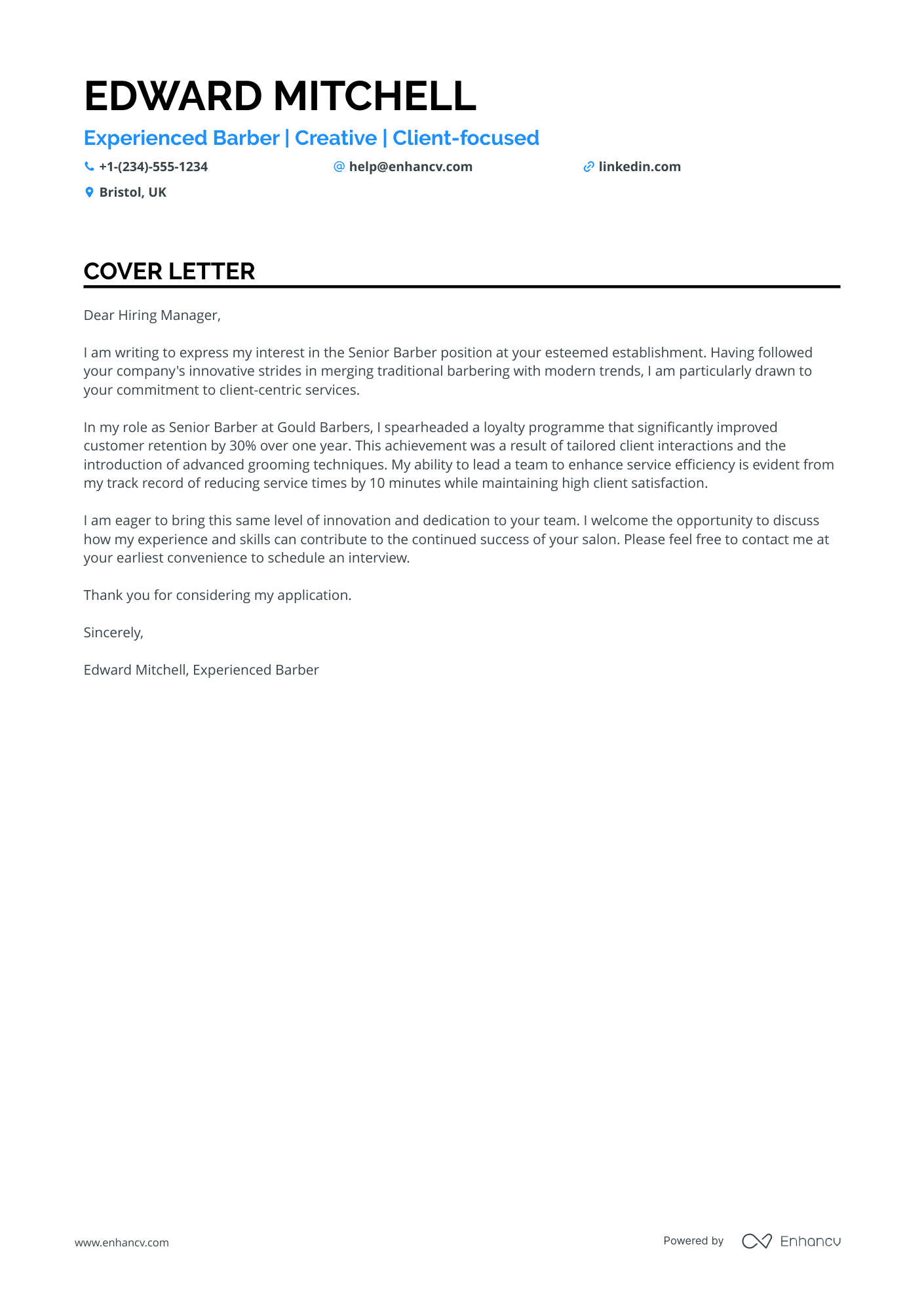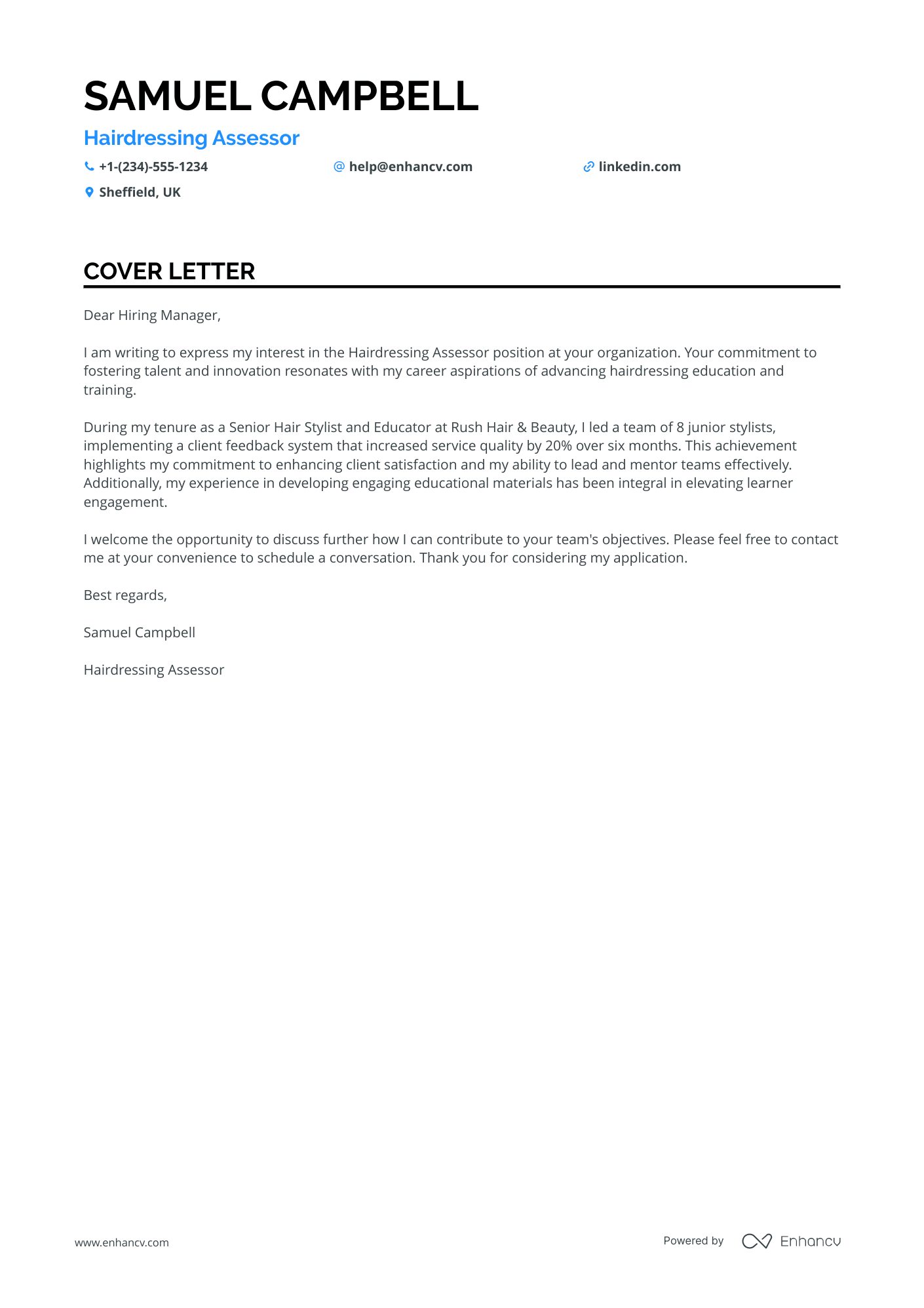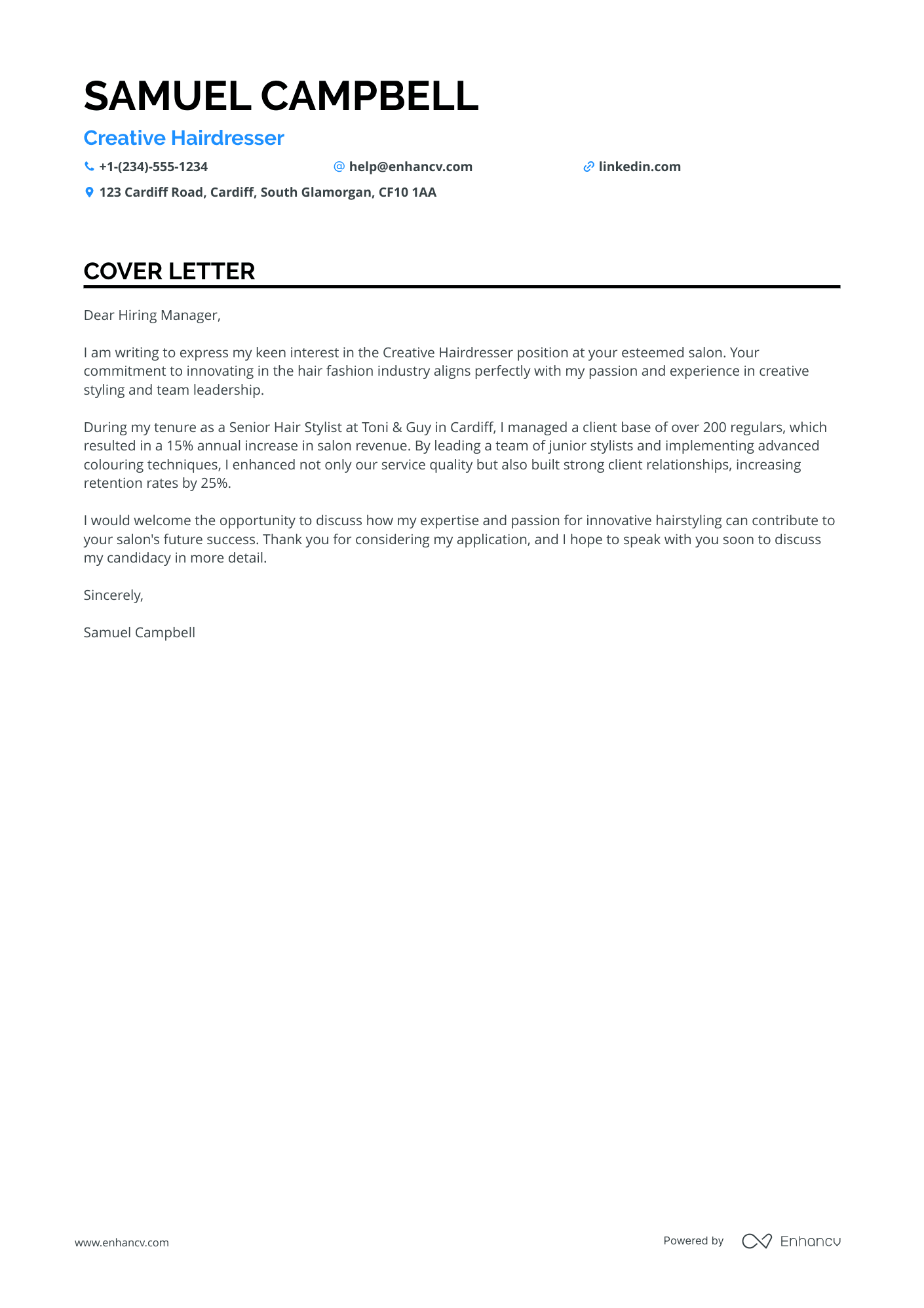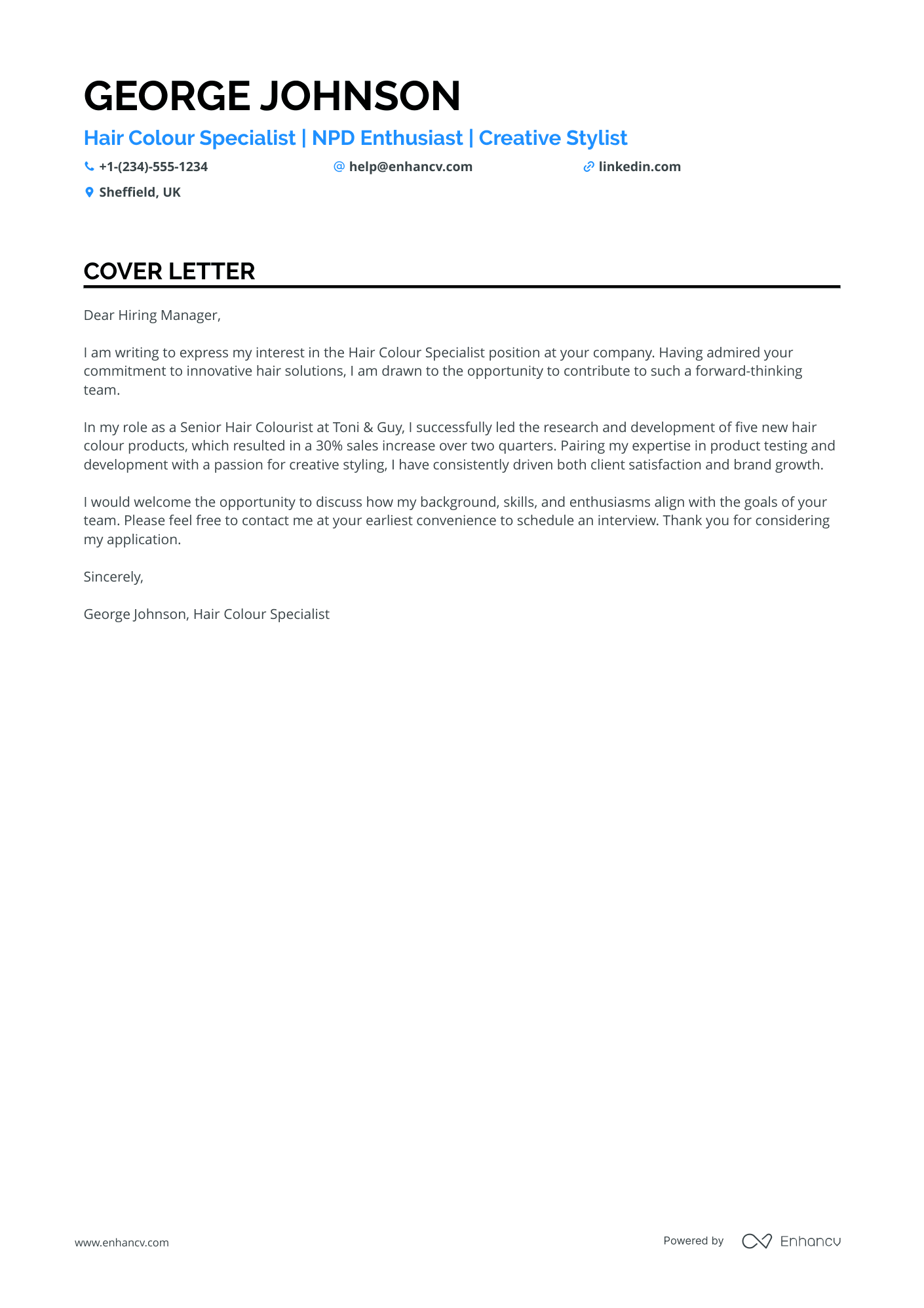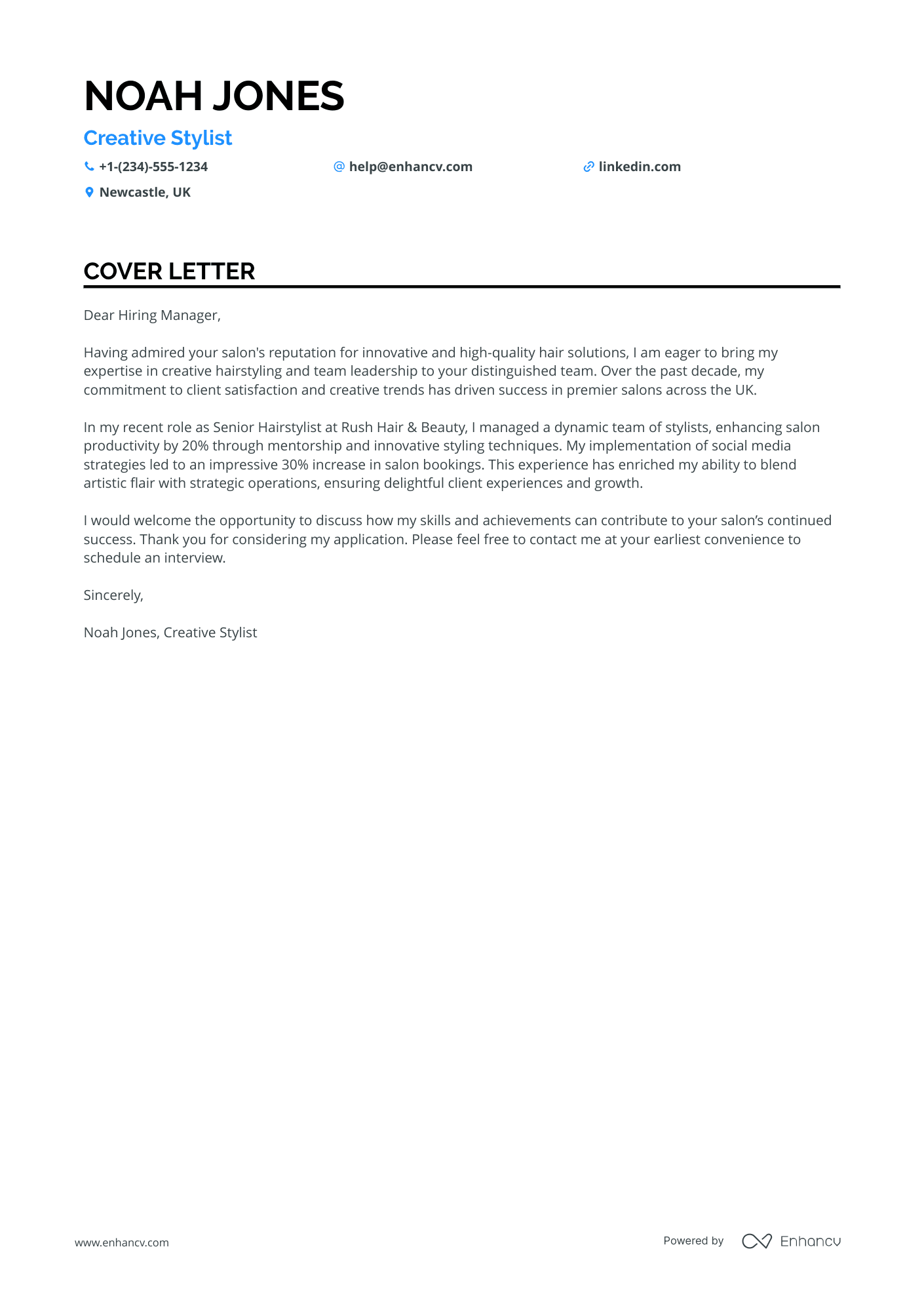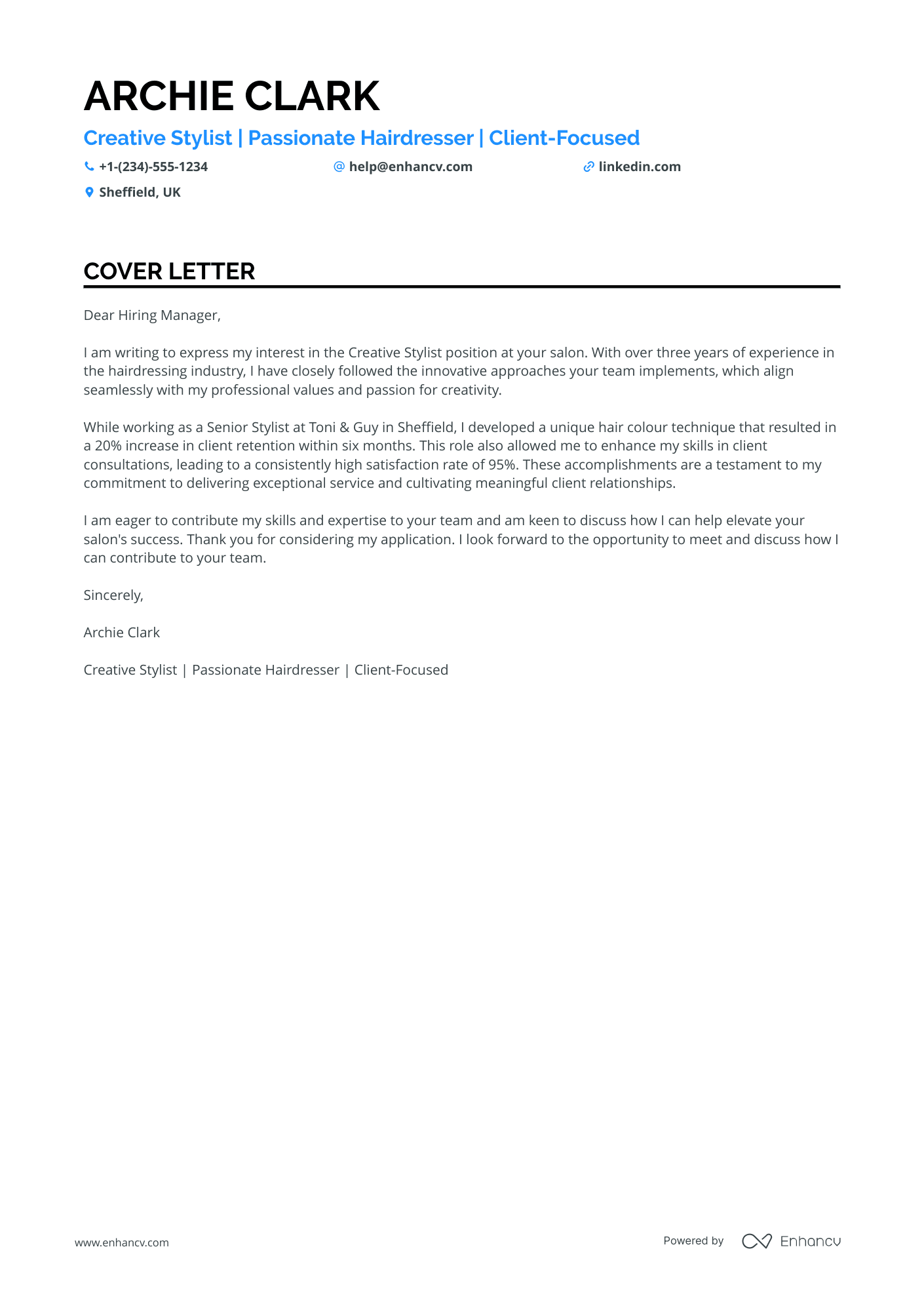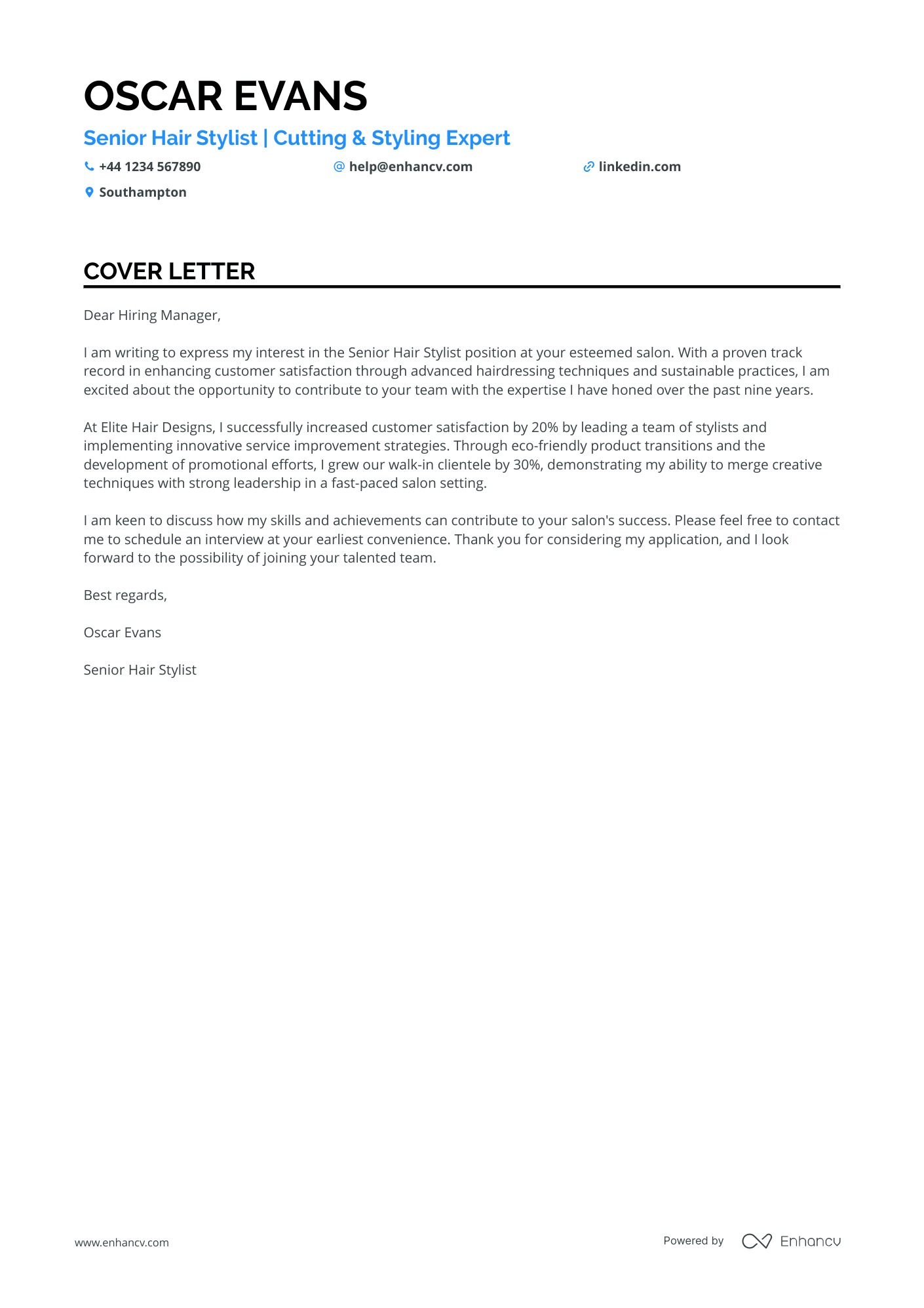When you start applying for jobs, you quickly realise that including a cover letter with your CV is a excellent way to stand out. But what should your cover letter focus on?
Should it emphasise your key achievements or simply list your responsibilities? And how can you effectively demonstrate that you're the ideal fit for the role?
One of the most common mistakes candidates make is either underselling themselves or overstating their experience.
In this guide, you’ll learn how to craft a compelling cover letter by showcasing your most significant professional achievement and telling the story behind it.
Cover letter examples for hairdresser
By Experience
Hairdresser Apprentice
- Specialisation in Afro Haircare: Emphasising expertise in Afro and multi-textured hair highlights suitability for salons looking to enhance or expand services catering to diverse client needs.
- Proven Leadership and Training Abilities: Detailing experience in leading teams and training apprentices demonstrates capability to manage and develop salon staff effectively.
- Innovation in Styling Techniques: Mentioning the development of new styling methods showcases creativity and talent for introducing innovative services that can attract more clients.
- Academic and Professional Development: Highlighting education and relevant courses signals dedication to continuous professional growth and staying updated with industry advancements.
Senior Hairdresser
- Emphasising Specialisation: The cover letter highlights Alice’s expertise in gents styling, an important detail for targeting potential employers in the male grooming sector.
- Achievement-Driven Approach: It effectively uses quantified results, such as a 50% boost in client retention and a 40% improvement in client visibility, to illustrate her positive impact on former employers.
- Relevance of Experience and Education: Alice’s experience in leading styling projects for fashion shows and her Master’s in Creative Hair Styling from the University of the Arts London showcases both her practical experience and academic credentials relevant to fashion-focused styling roles.
- Commitment to Community and Sustainability: Mentioning charity events and organic hair care courses not only shows community engagement but also aligns with modern sustainability trends, potentially appealing to eco-conscious salons.
Master Hairdresser
- Highlighting Certifications: Mentioning the "Aveda Advanced Colour Techniques Certification" is key for roles specialising in hair colouring, demonstrating advanced technical skills and brand knowledge.
- Showcasing Impactful Achievements: Focusing on tangible results like a 30% increase in client retention or a 40% rise in bookings due to promotional campaigns, underlines the ability to drive business growth.
- Emphasising Leadership and Mentorship: Detailing experience leading a team and conducting training sessions demonstrates the capacity for leadership and developing others, crucial for senior hairstylist roles.
- Sustainability Initiatives: Highlighting eco-friendly practices shows a commitment to sustainability, an increasingly important factor within industries today.
By Role
Mobile Hairdresser
- Professional Summary: Clearly outlines the candidate's extensive experience and specialties, such as elderly care and client satisfaction, crucial for roles that demand excellent personal interaction skills.
- Achievements: Emphasises quantifiable successes like a 30% increase in client satisfaction and 40% reduction in wait times, proving the candidate's impact in previous roles.
- Relevant Education and Training: Highlights relevant degrees and specialised courses, such as the Master of Science in Cosmetology and "Dementia Care for Hairdressers," showcasing qualification and commitment to professional development.
- Skills Alignment: Lists skills pertinent to the role like styling, scalp treatments, and elderly care, directly addressing the potential client's or employer's service needs.
Freelance Hairdresser
- Highlighting specific achievements such as increased client retention, customer satisfaction and team productivity demonstrates the candidate's impact and adds quantifiable value to past roles, which would be attractive to potential employers in the barber industry.
- Including certifications like the "Advanced Men's Haircutting Techniques" course showcases the candidate’s commitment to ongoing professional development and ensures they are equipped with modern skills, critical in a competitive field like barbering.
- Discussing leadership experience and the ability to implement new systems, such as customer feedback or loyalty programmes, indicates strong management skills that can be beneficial for growth and efficiency within a barber shop setting.
- Emphasising community engagement and collaboration with local businesses points towards effective networking and marketing skills, important for enhancing brand visibility and attracting a broader client base in the barbering field.
Wedding Hairdresser
- Emphasising the applicant's proficiency in creative colouring and styling, which aligns well with the dynamic salon environment and client demand for innovative hair designs.
- Highlighting the development and success of a new colouring technique that increased service demand by 25%, showcasing the applicant's ability to innovate and attract clients.
- Illustrating successful team leadership and client retention efforts, demonstrating skills vital for a senior stylist role, particularly in increasing client satisfaction by 30%.
- Noting the education in Fashion Styling and Creative Direction, indicates a strong foundation in style, creativity, and professional presentation, supporting the applicant’s role objective.
Hairdresser Trainer
- Highlighting Experience and Achievements: Chloe Bell effectively showcases her relevant experience as a Senior Hair Stylist, providing quantifiable achievements such as a 25% increase in client retention and a 30% increase in colour service bookings, thereby demonstrating her capability to drive business growth and client satisfaction.
- Emphasising Education and Professional Development: The cover letter incorporates Chloe's educational background in Hair and Beauty Management and Salon Management, providing a strong foundation for her expertise, alongside highlighting advanced training, such as courses from Vidal Sassoon Academy and L'Oréal Professional.
- Demonstrating Key Skills and Capabilities: The letter outlines skills vital to hairdressing roles, such as advanced cutting techniques, colour correction, and client relationship management, illustrating Chloe's comprehensive skill set that aligns with her professional responsibilities.
- Language Skills and Cultural Exposure: Chloe's proficiency in French and her passion for travelling suggest an openness to diverse customer interactions, which can be particularly beneficial in multicultural areas or for clients valuing multilingual service.
Hairdresser Assessor
- Highlighting Leadership Experience: The cover letter showcases Samuel's ability to lead and mentor a team, a crucial skill for a Hairdressing Assessor role. His experience in leading junior stylists and implementing staff development initiatives underlines his leadership potential.
- Emphasising Educational Contributions: Samuel's contribution to developing educational materials and training workshops highlights his passion and capability in an educational role, essential for a position focused on assessing and training emerging stylists.
- Showcasing Industry Recognition: Mentioning awards like the 'Sales Excellence Award' and 'Top Stylist Award' reinforces his expertise and reputation in the industry, enhancing credibility in a specialised field like hairdressing assessment.
- Highlighting Continuous Professional Development: Completing the TAQA Assessor course indicates a commitment to professional growth and staying updated with industry standards, making him a strong candidate for roles requiring current assessment skills.
Hairdresser Salon Manager
- Emphasise relevant experience in salon management and client retention, highlighting a 40% increase in retention, which showcases expertise in maintaining and growing a client base.
- Include specific certifications like the "Advanced Hair Cutting Techniques" from the Sassoon Academy and "Creative Colour Solutions" from L'Oréal Academy to demonstrate specialised skills in modern hairstyling trends and advanced colour techniques.
- Highlight achievements in leadership and team mentoring, such as the "Leadership in Mentoring" award, to convey the ability to enhance team skills and service quality effectively.
- Discuss successful implementation of innovative systems and creative projects like the new client appointment system and creative portfolio projects, demonstrating efficiency and marketing acumen.
Hairdresser Educator
- The cover letter effectively highlights relevant positions and experiences, such as the role of Senior Hair Stylist at Toni & Guy where specific achievements like managing a large client base and increasing revenue are showcased.
- It incorporates specialised certifications from esteemed institutions like Vidal Sassoon Academy and L'Oréal Academy, underscoring expertise in innovative and modern hairstyling techniques.
- Mentorship and leadership skills are emphasised, demonstrated through achievements in team skill improvements and successful training sessions that contribute to overall salon performance.
- A passion for innovative styling and a track record of organising impactful community events are highlighted, which align with the role's need for creativity and strong client relations.
Celebrity Hairdresser
- Highlight Key Achievements: The cover letter effectively showcases measurable achievements, such as a 20% increase in digital engagement and 15% rise in client retention, which are significant indicators of the candidate's impact in previous roles.
- Relevant Experience in Digital Media: It emphasises the candidate's proficiency in creating and executing digital media strategies, an essential skill for a Creative Hairstylist looking to market trends and techniques in the modern, digital-driven industry.
- Demonstrating Leadership Skills: The cover letter illustrates leadership experiences, such as coaching new stylists and leading content strategy teams, underscoring the applicant's capability to manage and enhance team performance.
- Emphasis on Continued Professional Development: By mentioning tailored courses and certifications related to advanced hairstyling techniques and digital content strategy, the applicant demonstrates a commitment to staying updated with industry trends and skills.
Cruise Ship Hairdresser
- Emphasising achievements: The cover letter effectively showcases specific accomplishments, such as increasing salon revenue by 30%, which demonstrates the applicant’s impact and ability to contribute positively to a prospective employer.
- Highlighting specialised skills and experience: Specific skills like product upselling, team training, and managing inventory and scheduling are particularly relevant for the role of a hairdresser and stylist with salon management responsibilities.
- Certifications and education: Mentioning a Bachelor of Arts in Hair and Makeup for Fashion, a Master of Science in International Spa Management, and certifications from recognised institutions such as Vidal Sassoon and CIDESCO reinforces the applicant’s expertise and commitment to professional development.
- Passion and personal interests: Demonstrating a passion for hairstyling innovation, sustainable beauty practices, and integrating travel and culture experiences can make the applicant stand out by showcasing personality and industry trends awareness.
Theatrical Hairdresser
- Emphasises specialisation in Afro and Mixed Race hair care, showcasing unique expertise in a niche area highly relevant to the role.
- Highlights a 95% client return rate and a 30% increase in salon revenues, demonstrating strong client relationship management and business acumen.
- Showcases leadership and mentoring abilities through achievements like improving junior stylist performance by 40% and initiating successful training programs.
- Incorporates relevant certifications, such as Advanced Afro Hair Techniques, which underscore technical proficiency and continuous professional development.
Film and TV Hairdresser
- Emphasising achievements such as increasing client retention by 25% through personalised consultations, demonstrating the ability to build strong customer relationships and satisfaction.
- Mentioning participation in prestigious training workshops like the Creative Hair Styling Workshop by TONI&GUY London Academy, showcasing commitment to staying current with industry trends and skills.
- Highlighting advanced skillsets such as Creative Hair Styling and Advanced Colour Techniques, which are crucial for a role focused on innovative and high-quality styling services.
- Illustrating leadership and mentoring capabilities by discussing the development and implementation of a training module that was adopted company-wide, evidencing ability to influence and guide a team effectively.
Hairdresser Stylist
- Specialised Certifications: Highlighting the completion of "Advanced Hair Colour Techniques" at Sassoon Academy and "Salon Management Certification" from the London Hair Academy demonstrates a higher level of expertise and commitment to professional growth essential for a Creative Stylist role.
- Client Satisfaction and Retention: Emphasising achievements such as a 95% client satisfaction rate and a 20% increase in client retention through innovative colour techniques underscores the candidate's client-focused approach and creativity.
- Leadership and Mentorship: Showcasing experience in mentoring junior stylists, which led to a 25% improvement in their performance, reflects leadership abilities and a commitment to team development, valuable attributes in a senior stylist role.
- Operational Efficiency: Mentioning the implementation of a streamlined appointment booking system that increased productivity by 30% demonstrates the candidate's ability to enhance operational efficiency and client service quality.
Hairdresser Colour Specialist
- Highlight Relevant Experience: George effectively showcases his experience with a well-established company like Toni & Guy, where he has led significant product development projects and enhanced customer satisfaction, making him an appealing candidate for roles requiring innovation in hair colour.
- Specialised Skills and Achievements: The cover letter emphasizes George's proficiency in colour correction and bleaching, supported by achievements like increasing customer satisfaction by 20% through innovative solutions, which are critical skills for a Hair Colour Specialist.
- Professional Development: Mentioning certifications such as "Advanced Colour Correction Techniques" from Vidal Sassoon Academy positions George as someone committed to ongoing professional development, a valuable trait for staying current in the hairdressing industry.
- Passion for Sustainability: George aligns personal passions with professional goals by expressing a commitment to sustainable haircare, which can resonate with organisations focused on environmentally friendly practices.
Hairdresser Salon Owner
- Highlighting the "Advanced Colour Techniques Certification" emphasises specialised skills that precisely cater to the core responsibilities of a Professional Hairdresser and Colour Specialist, showcasing proficiency in niche areas.
- Including a summary of increased client retention and customer satisfaction demonstrates the candidate's effectiveness in client relationship management, an essential skill in maintaining and growing clientele in a hairdressing role.
- Emphasising "Building Community Engagement" as a passion illustrates the candidate's commitment to promoting the salon and attracting new clients by participating in local events and activities.
- Showcasing experience in multiple reputable hair salons like Toni & Guy and Regis Salons lends credibility and affirms expertise, essential for establishing trust and reputation in this industry.
Hairdressing Team Leader
- Highlight Specific Skills and Techniques: Emphasise advanced colouring techniques, such as Balayage, which are crucial in the hairstyling industry. This showcases your expertise in offering diverse and modern services to potential employers.
- Showcase Leadership and Mentoring Capabilities: Mention your experience in leading and mentoring junior stylists, as well as organising workshops for skill enhancement. This demonstrates your ability to inspire and increase the proficiency of a team.
- Utilise Achievements to Prove Competence: Point out notable achievements, such as maintaining a high client satisfaction rate and receiving industry awards. These accolades support your credibility and superiority in the field.
- Emphasise Innovative and Trend-driven Approaches: Express your passion for hairstyling innovations and trends, which illustrates your commitment to staying current and providing cutting-edge solutions in a dynamic salon environment.
Hairdresser Product Consultant
- Highlight of experience in education delivery and salon expertise that aligns well with the role of an Education Consultant, showcasing proficiency in training over 100 salons and increasing stylist proficiency significantly.
- Emphasis on innovative retail strategy skills, showcasing a 45% boost in product sales within a short timeframe, an essential aspect for roles focusing on business growth and development.
- Inclusion of specific achievements such as mentoring junior stylists and establishing a programme that decreased turnover by 25%, displaying leadership and talent development capabilities critical for advancing stylists' careers.
- Promotion of advanced certifications such as the Creative Hair Colour Techniques from Vidal Sassoon Academy, emphasising technical excellence and continuous professional development in specialised areas.
Hairdresser Sales Representative
- Highlighting substantial experience in customer service roles across different companies, showcasing a proven track record in enhancing customer satisfaction and team performance.
- Emphasising achievements such as increased sales conversions and improved customer satisfaction scores, illustrating direct impact on business success.
- Showcasing educational qualifications including a Bachelor of Arts in Communication and an MBA, which align with essential communication and managerial skills for a customer service specialist role.
- Featuring industry-specific skills such as CRM systems, upselling, and regulatory compliance, critical to the effective management of customer relations and sales processes.
Hairdresser cover letter example
Oscar Evans
Southampton
+44 1234 567890
help@enhancv.com
- Highlighting Leadership and Results: Emphasizing a proven track record in a leadership role with quantifiable results, such as customer satisfaction improvement and clientele growth, shows the potential to contribute to a salon's success.
- Emphasizing Innovation and Eco-consciousness: Mentioning the implementation of eco-friendly practices shows awareness of current trends and appeals to salons that value sustainability.
- Expressing Enthusiasm and Availability: Demonstrating eagerness by expressing interest in discussing contributions further, indicating an open line for communication, and the willingness to join the team enthusiastically is compelling.
Importance of cover letters in the United Kingdom
Cover letters are a vital part of professional job applications, helping shape recruiters' first impression of your profile.
Here’s why they’re important:
- Indicates your genuine interest: A well-researched cover letter reflects your knowledge of the company and role.
- Professionalism from the outset: Employers expect your cover letter to be structured, polite, and formal. If you wish to add a more personalised touch, be sure to address your recipient directly.
- Capture the recruiters' attention: For most roles, candidates tend to have rather similar experience, which is why you should use your cover letter to explain what is unique about your profile.
What UK employers expect from a cover letter
A great cover letter can set you apart when applying for jobs in the UK.
Follow these tips to ensure you make a strong impression:
- Research thoroughly: Spend time delving into the company’s website, social media, and industry news to understand their projects, awards, and future plans. The more specific your knowledge, the better you’ll be able to demonstrate your suitability for the role.
- Reflect their values: Every UK company has its own set of values that guides their culture. Once you’ve identified them, make sure your cover letter reflects how your values and work ethic align with theirs. If they’re known for integrity, emphasise your commitment to ethical practices.
- Tailor your skills: Focus on aligning your most relevant skills with the job description. Look for key terms and priorities mentioned in the advert, and make sure to provide examples of how you excel in those areas.
How to format a hairdresser cover letter
To get your cover letter's formatting right:
- Use a modern font like Lato, Raleway, or Chivo, rather than the overused Arial or Times New Roman.
- Set your cover letter to be single-spaced with 1-inch (2.5 cm) margins on all sides—our templates are automatically set up for you.
- Ensure both your CV and cover letter are consistent in font style and formatting.
- Always send your cover letter as a PDF to prevent alterations and preserve its layout.
When it comes to structuring your cover letter, follow this sequence: begin with your address and contact details, then the employer's details (i.e. name and address), and the date. Next, start with a personalised greeting, followed by your introductory, body, and closing paragraphs. Be sure to include a sign-off and your signature at the end.
Remember, although Applicant Tracking Systems (ATS) software, which may scan your CV for keywords, won't read your cover letter, it will be reviewed by recruiters.
How to write your hairdresser cover letter salutation
First impressions often start with the greeting and in the case of your job application, 'Dear Sir or Madam' simply won't suffice.
Find out who’s hiring for the role—by calling or emailing the company, searching online, or using LinkedIn—and address them correctly.
Generally, you should address them by their surname (e.g., 'Dear Mrs Weasley'), but if you've spoken to them before, you might use their first name (e.g., 'Dear Albus').
How to write your hairdresser cover letter intro
It's never a bad time to show enthusiasm about the role, company, or team in your cover letter introduction.
Begin by sharing one or two aspects that genuinely excite you about the position—whether it's the company culture, specific responsibilities, or the team's past achievements.
Your enthusiasm demonstrates that you'll bring a strong work ethic, are eager to contribute, and are motivated to succeed.
How to write your hairdresser cover letter body
Which makes for a stronger cover letter body: a long-winded account of everything you’ve ever done, or a focused achievement that’s directly relevant to the job?
Hint: recruiters prefer the second.
When writing your cover letter, select your most impressive achievement that:
- Directly aligns with the job description and role.
- Is quantifiable with tangible metrics like numbers or percentages.
- Maps out your hard and soft skills, showcasing what makes you unique.
- Tells the story of the impact you could have on the organisation.
How to write a closing paragraph
There’s a wrong and a right way to close your cover letter. Here’s how.
The wrong way is to end with a signature or a formal 'Thank you in advance.'
The right way is to either promise how you’d make a positive impact on the company or ask when you can expect a response. This will highlight you as a forward-thinking candidate who’s enthusiastic about securing the role.
Conclusion
Your cover letter is an opportunity to showcase your personality and skills to potential employers. Start by addressing the hiring manager by name and tailoring your content to reflect the role’s requirements.
Include a specific example of your greatest achievement to illustrate your suitability for the position, while also expressing your enthusiasm for the company. Remember to format your letter professionally, ensuring it aligns seamlessly with your CV.




